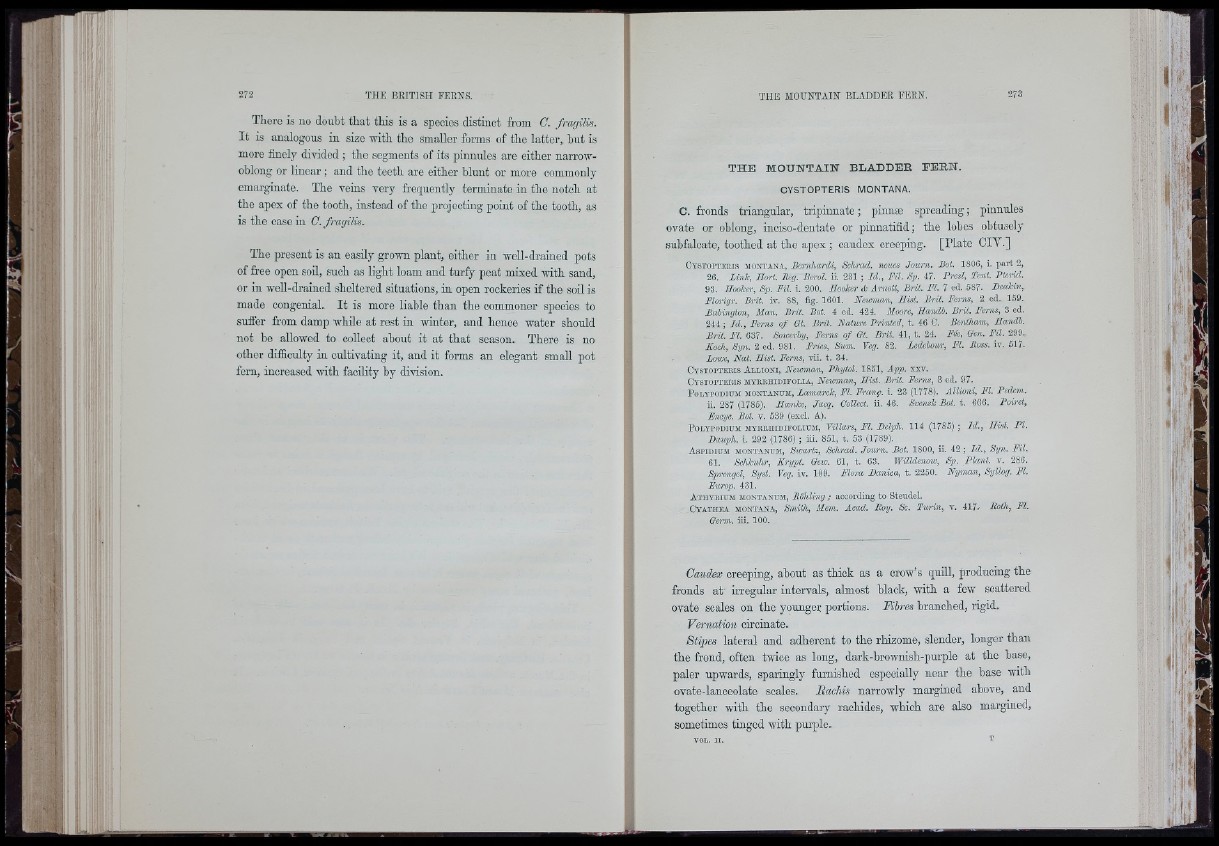
lUii
■11
There is no doubt that this is a species distinct from. C. fragilis.
It is analogous iu size with tho Smaller forms of the latter, but is
moro finely divided ; tho segments of its pinnules arc cither narrow-
oblong or linear ; and tho teeth are cither blunt or more commonly
emarginate. The veins very frequently terminate in the notch at
the apex of the tooth, instead of the projecting point of the tooth, as
is the case in C. fragilis.
The present is an easily grown plant, either in well-drained pots
of free open soil, such as light loam and turfy peat mixed with sand,
or in well-drained sheltered situations, in open rockeries if the soil is
made congenial. It is more liable than the commoner species to
suffer from damp while at rest iu winter, and hence water should
not be allowed to collect about it at that season. There is no
other difficulty in cultivating it, and it forms an elegant small pot
fern, increased with facility by division.
THE MOUNTAIN BLADDER EERN.
CYSTOPTERIS MONTANA.
C. fronds triangular, tripinnate ; pinnæ spreading ; pinnules
ovate or oblong, inoiso-dentate or pinnatifid; the lohes obtusely
subfalcate, toothed at the apex ; caudex creeping. [Plate CIV.]
C y s t o p t e e is m o n t a n a , Bernhardi, Schrad. neitcs J o um . Bot. 1 8 0 6 , i. p a r t 2,
2 6 . Milk, Hm-t. Beg. Berol. Ü. 2 3 1 ; Id ., Fil. Sp. 4 7 . Presi, Tent. Pterid.
9 3 . Hooker, Sp. Fil. i. 2 0 0 . Hooker A Amott, Brit. PI. 7 e d . 5 8 7 . Heakin,
Florigr. Brit. iv . 88, fig , 1 6 0 1 . Nevmian, Hist. Brit. Ferns, 2 e d . 1 5 9 .
Babingkm, H a n . Brit. Bot. 4 c d . 4 2 4 . Moore, Handb. Brit. Ferns, 3 e d .
2 4 4 ; Id ., Ferns o f Gt. B r i t Nature Printed, t. 4 6 C. BenOiam, Handb.
B r i t Fl. 6 3 7 . Sowerby, Ferns o f Gt B r i t 4 1 , t . 2 4 . Fée, Gen. Pil. 2 9 9 .
Koeh, Syn. 2 e d . 9 8 1 . Piles, Sum. Veg. 8 2 . Ledebour, Fl. Boss. iv . 5 1 7 .
Lowe, Nat. Hist. Fcms, v i i . t . 34.
Cy sto pte e is A l l ig n i, Newman, Phytol. 1 8 5 1 , App. xxv.
Cysto pte e is m y k e h id ifo l ia , Newman, H is t B r i t Ferns, 3 e d . 97.
P olypodium montanum, Lamarck, Fl. Franç. i. 2 3 (1 7 7 8 ) . Allioni, Fl. Pedem.
Ü. 2 8 7 (1 7 8 5 ). Hamke, Jacg. Collect ii, 4 6 . Seensk B o t t . 666. Poiret,
Eneyc. B o t v, 639 (excl. A).
P olypodium m y e e h id if o l ium , Villars, Fl. Helph. 1 1 4 (1 7 8 5 ) ; Id ., H is t PI.
Dauph. i. 2 9 2 (1 7 8 6 ) ; i i i. 8 5 1 , t . 63 (1 7 8 9 ).
As p id iu m montanum, Swartz, Sehrad. Journ. Bot. 1 8 0 0 , i i . 4 2 ; Id ., Syn. Fil.
6 1 . Sehkuhr, K r y p t Gew. 6 1 , t . 6 3 . Willdenow, Sp. P la n t v . 2 8 6 .
Sprengel, S y s t Veg. i r . 1 0 9 . Flora Danica, t . 2 2 5 0 . Nyma n , Syllog. PI.
Europ. 4 3 1 .
A t h y e ium montanum, Roliling ; according to Steudel.
Cy a t h e a montana, Smith, Mem. Aead. Roy. Sc. T u rin , v, 417^ Roth, F l.
Germ, iii, 100.
Caudex creeping, about as thick as a crow’s quill, producing the
fronds at irregular intervals, almost black, with a few scattered
ovate scales on the younger portions. Fibres branched, rigid.
Vernation circinate.
Stipes lateral and adherent to the rhizome, slender, longer than
the frond, often twice as long, dark-brownish-purple at the base,
paler upwards, sparingly furnished especially near the base with
ovate-lanoeolate scales. Rachis narrowly margined above, and
together with the secondary rachides, which are also margined,
sometimes tinged with purple.
l l
u
•bi
bl
d/‘’i
( I d
i h
i'l!
fl